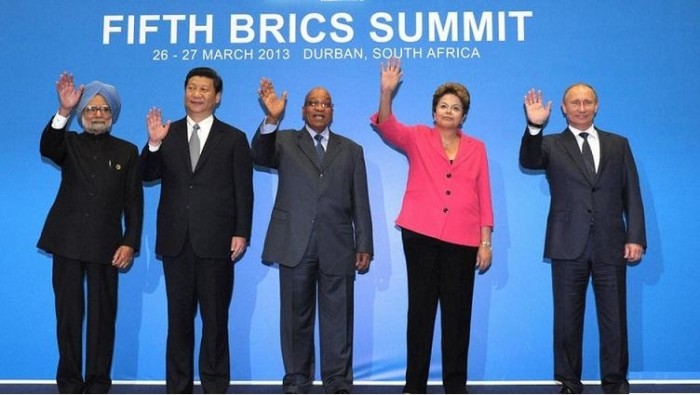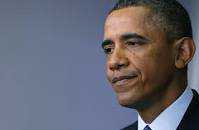BRICS summit conclusion – announce intent to establish new development bank for emerging/developing economies
At the conclusion of their summit in Durban in March, the leaders of the BRICS (Brazil, Russia, India, China, and South Africa) announced their intention to establish a New Development Bank aimed at “mobilizing resources for infrastructure and sustainable development projects in BRICS and other emerging economies and developing countries.”
Illustration by Chris Van Es
CommentsView/Create comment on this paragraphThe significance of this decision cannot be overemphasized. For starters, it reflects the enormous successes in economic development during the last four decades (the BRICS’ aggregate GDP is now greater than that of the advanced countries when the Bretton Woods institutions were founded) and the rebalancing of global economic power that this implies. Indeed, the decision demonstrates the BRICS’ ability and willingness to work together, for their own benefit and for that of the entire world. Emerging markets and developing countries are taking the future into their own hands – at a time when rich countries are muddling through their own self-inflicted problems.
CommentsView/Create comment on this paragraphA new development bank is clearly needed. The infrastructure requirements alone in emerging-market economies and low-income countries are huge – 1.4 billion people still have no reliable electricity, 900 million lack access to clean water, and 2.6 billion do not have adequate sanitation. At the same time, an estimated two billion people will move to cities in the next quarter-century. And policymakers must ensure that the investments are environmentally sustainable.
CommentsView/Create comment on this paragraphTo meet these and the other challenges confronting the developing world, infrastructure spending will have to rise from around $800 billion to at least $2 trillion annually in the coming decades. Otherwise, it will be impossible to achieve long-term poverty reduction and inclusive growth.
CommentsView/Create comment on this paragraphWhile the private sector can meet some of these needs, it can go only so far, especially given the nature of infrastructure projects’ risks, the huge upfront costs, and the high cyclical sensitivity of global financial markets. The funding gap is beyond what existing international financial institutions can meet – and the advanced countries’ malaise means that significant recapitalization is not in the cards. Annual infrastructure financing from multilateral development banks and overseas development assistance is likely to amount to no more than $40-60 billion, or 2-3% of projected needs.
CommentsView/Create comment on this paragraphA development bank anchored in emerging markets and developing countries can help to address this gap and become a powerful catalyst for change, both in the developing world and – through collaboration and example – in existing institutions. The world today is markedly different from the world at the time of the founding of the World Bank and many of the regional development banks. The BRICS’ proposed New Development Bank presents an important opportunity to reflect these changes, with modern financial instruments, strong governance, and a broad-based mandate.
CommentsView/Create comment on this paragraphFor example, changes in financial markets (including the large amounts of money in sovereign wealth funds and public pension funds) provide opportunities for new development partnerships, which the New Development Bank can help to catalyze and orchestrate. So, too, should its deployment of a wide range of modern instruments enable it to meet the diverse range of project needs while ensuring adequate risk management.
CommentsView/Create comment on this paragraphThe new bank should maximize its multiplier effects by sharing and reducing risk through collective action and “crowding in” other financing; by setting a powerful example in adopting innovative and cost-effective approaches; and through its policy and institutional impact beyond projects that it finances.
CommentsView/Create comment on this paragraphWhile the older institutions have attempted to adapt, their governance remains out of sync with today’s economic and political realities. The new bank’s governance structure has yet to be worked out, but it promises to be more consistent with contemporary best practices. Most important, the New Development Bank will give greater voice to the perspectives and interests of those in developing countries and emerging markets.
CommentsView/Create comment on this paragraphAs with the outdated governance arrangements, conceptions of development that informed the existing multilateral institutions’ mandates are markedly different from modern development thinking. For example, there was no awareness of the challenge posed by climate change, and that all countries (including those in the developing world) must reduce their greenhouse-gas emissions and adapt to changes that will be particularly adverse to poor countries. Likewise, there was no comprehension of the innovation and opportunities entailed in pursuing more sustainable paths of inclusive economic growth.
CommentsView/Create comment on this paragraphOf course, the World Bank and the regional development banks now recognize such imperatives, and the New Development Bank should not relieve the developed countries of their responsibilities. But, with the shortfall of assistance from developed to developing countries, the new bank can provide essential help to developing countries and emerging markets as they undertake smarter and more sustainable infrastructure investment for growth and poverty reduction. Given the need to act quickly – and given the slowness with which the developed world has been responding – this new institution is all the more welcome.
CommentsView/Create comment on this paragraphThe new bank can make a major contribution to the global economy’s health by facilitating the transition to new poles of growth and demand, helping to rebalance global savings and investments, and channeling excess liquidity to productive use. It will not only be a driver for sustainable growth in the developing and emerging world, but will also foster reform in the existing multilateral financial institutions – changes from which all of us, in the developed and developing world alike, will benefit.
Read more at http://www.project-syndicate.org/commentary/the-benefits-of-the-brics-development-bank#JqKwSZg0iLABAiYA.99













